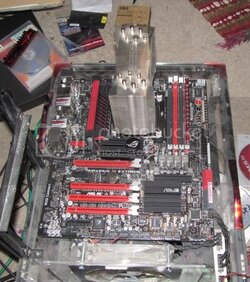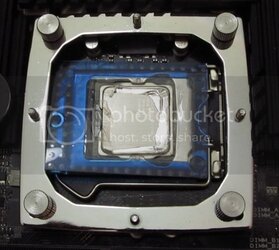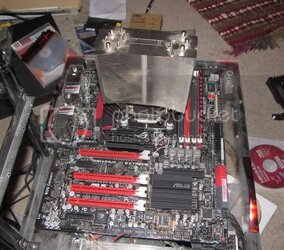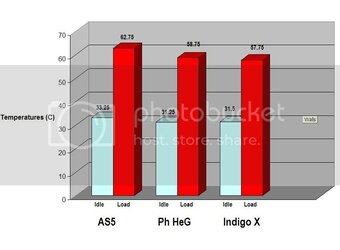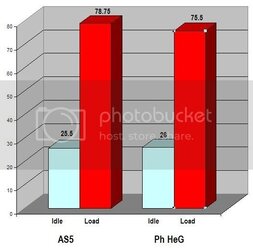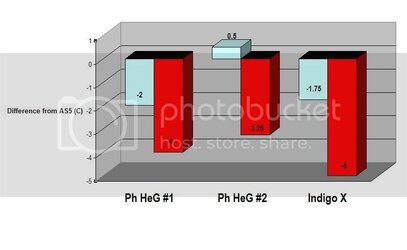- Joined
- Dec 7, 2003
Hi!
I recently was in the process of a new build (a little self-advertisement: Project Vitis)
So I decided to try some new thermal compound.
I’ve used Arctic Silver 5 for what like a decade, but after poking around other reviews I decided to try Phobya HeGrease and the radical Indigo Xtreme.

http://www.arcticsilver.com/as5.htm

http://www.phobya.com/eng/phobya.html

http://indigo-xtreme.com/
For those of you not in the know, Phobya HeGrease is another thermal compound.
Indigo Xtreme is a whole nother beast. It comes as strip of low-melting-temp metal compound in a pre-packaged plastic unit. You stick the plastic unit on the IHS of the cpu, then install your heatsink. Then you must run the system without a fan to intentionally heat the metal compound, causing it to liquefy and reflow between the IHS and heatsink forming a voidless contact pad.
I’m going to emphasize here, this is not a scientific review. I was really doing a build and since I was going to try some new compounds, I figured I’d just put my numbers and experience out there.
Rules of Engagement
Hardware for the main system in question is:
Asus Maximus Extreme IV P67
2x 4gb G.Skill
Corsair HX Powersupply
260 GTX video card
i7 2500k at 4.5ghz, core at 1.3v, as measured by DMM Idle 1.293v, Load 1.289v
Open benching station
Thermalright Ultra Extreme
2 Yate Loon D12-SL12 run at 12v in Push-Pull
Temperatures were measured with Realtemp.
System was powered on and left idle for an hour. Realtemp logs for the minimal temps for each core were noted, then averaged. This was the Idle temp.
Load was generated by OCCT for 15 minutes.
Realtemp logs for maximal temps were noted then averaged. This was the Load temp.
Regarding curing time. AS5 systems (being my original applications) were cured for months. All else were not.
Application. I apply my AS5 and HeGrease by making a very thin square in the middle of the IHS approximately ½ the length and width of the IHS. That’s how I do it.
Indigo Xtreme—see specific notes.
Because of my success with Phobya HeGrease, I also changed over my personal system (System#2) and I included the data from that change from AS5 to HeGrease. System#2 is an Asus P67 Sabertooth, i7 26k at 4.8ghz 1.35v, Thermalright Venemous X, 2 gelid fans bios controlled.
I recently was in the process of a new build (a little self-advertisement: Project Vitis)
So I decided to try some new thermal compound.
I’ve used Arctic Silver 5 for what like a decade, but after poking around other reviews I decided to try Phobya HeGrease and the radical Indigo Xtreme.
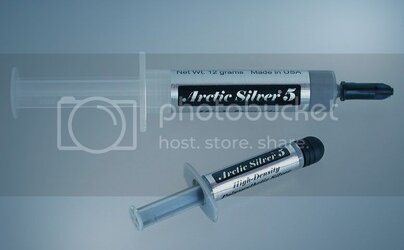
http://www.arcticsilver.com/as5.htm
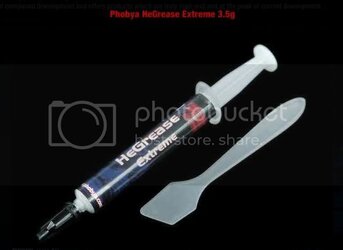
http://www.phobya.com/eng/phobya.html
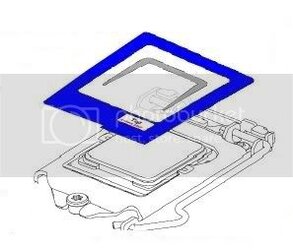
http://indigo-xtreme.com/
For those of you not in the know, Phobya HeGrease is another thermal compound.
Indigo Xtreme is a whole nother beast. It comes as strip of low-melting-temp metal compound in a pre-packaged plastic unit. You stick the plastic unit on the IHS of the cpu, then install your heatsink. Then you must run the system without a fan to intentionally heat the metal compound, causing it to liquefy and reflow between the IHS and heatsink forming a voidless contact pad.
I’m going to emphasize here, this is not a scientific review. I was really doing a build and since I was going to try some new compounds, I figured I’d just put my numbers and experience out there.
Rules of Engagement
Hardware for the main system in question is:
Asus Maximus Extreme IV P67
2x 4gb G.Skill
Corsair HX Powersupply
260 GTX video card
i7 2500k at 4.5ghz, core at 1.3v, as measured by DMM Idle 1.293v, Load 1.289v
Open benching station
Thermalright Ultra Extreme
2 Yate Loon D12-SL12 run at 12v in Push-Pull
Temperatures were measured with Realtemp.
System was powered on and left idle for an hour. Realtemp logs for the minimal temps for each core were noted, then averaged. This was the Idle temp.
Load was generated by OCCT for 15 minutes.
Realtemp logs for maximal temps were noted then averaged. This was the Load temp.
Regarding curing time. AS5 systems (being my original applications) were cured for months. All else were not.
Application. I apply my AS5 and HeGrease by making a very thin square in the middle of the IHS approximately ½ the length and width of the IHS. That’s how I do it.
Indigo Xtreme—see specific notes.
Because of my success with Phobya HeGrease, I also changed over my personal system (System#2) and I included the data from that change from AS5 to HeGrease. System#2 is an Asus P67 Sabertooth, i7 26k at 4.8ghz 1.35v, Thermalright Venemous X, 2 gelid fans bios controlled.
Last edited:
